Dell XPS 15 OLED (2022) vs MacBook Pro 16-inch: Which laptop wins?
Both are great laptops, but which should you buy?
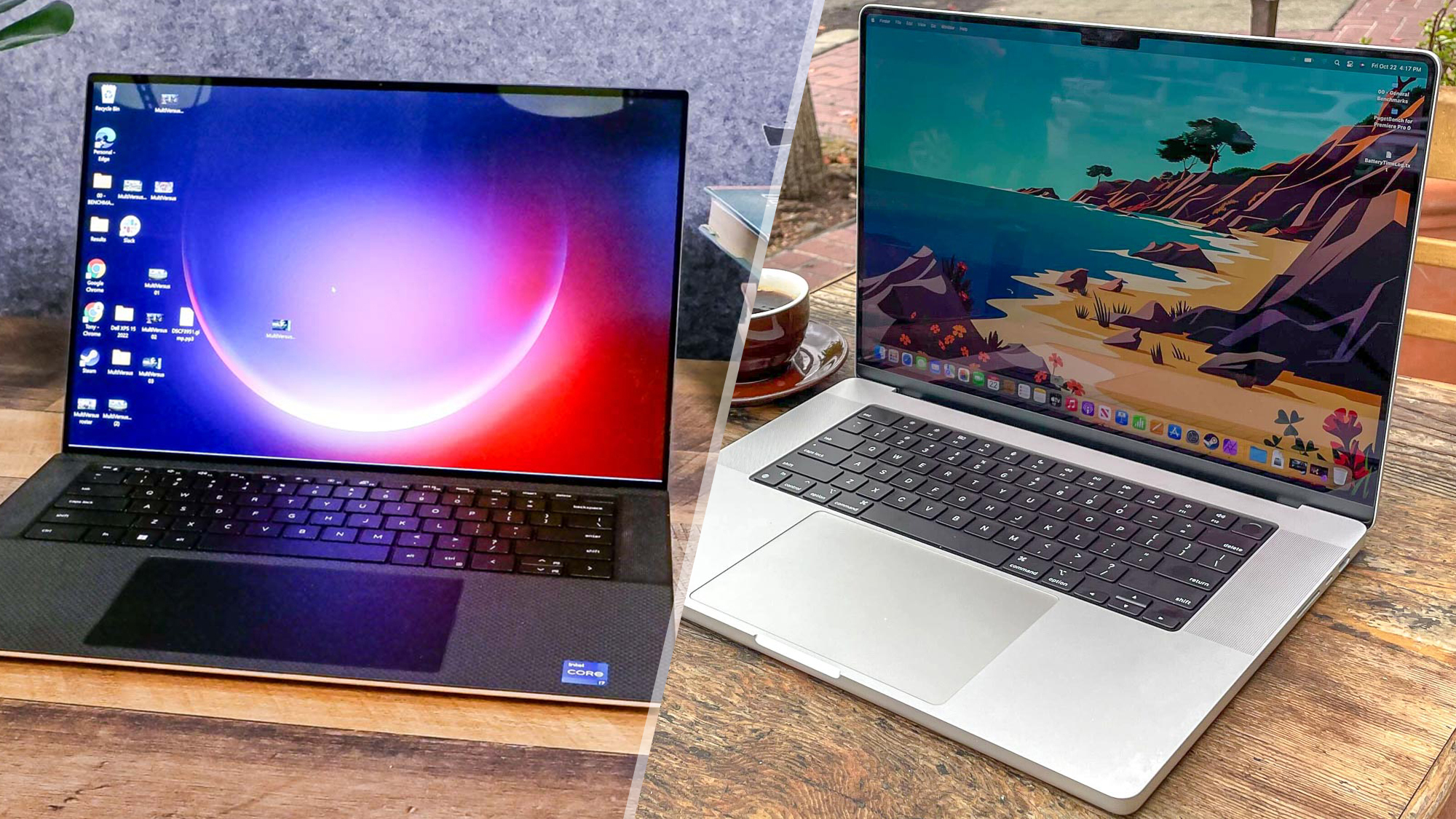
The Dell XPS 15 OLED (2022) vs MacBook Pro 16-inch (2021) debate is an interesting one. They’re each exceptional notebooks that easily claimed a spot in our best Windows laptops and best MacBooks lists, respectively. These machines exemplify the virtues of their respective platforms, but there's more to them than just PC vs. Mac.
Though you can’t go wrong with either laptop, one might be more appealing to you depending on your preferences and needs. It’s a tough decision, but factors such as operating system, performance and gaming potential will help steer you toward a particular machine.
Below, we pit the Dell XPS 15 OLED (2022) against the MacBook Pro 16-inch to help you determine which is best for you. Here’s how these two premium laptops stack up.
Dell XPS 15 OLED (2022) vs MacBook Pro 16-inch: Specs
| Row 0 - Cell 0 | Dell XPS 15 OLED (2022) | Apple MacBook Pro 16-inch (2021) |
| Price | $1,449 (starting), $2,299 (tested) | from $2,499 |
| Display | 15.6-inch OLED touchscreen (3,456 x 2,160 pixels) | 16.2-inch Liquid Retina XDR display (3456x2244 pixels, 254ppi) |
| CPU | Intel Core i7-12700H | M1 Pro (10-core CPU, 16-core GPU) |
| GPU | Integrated 16-core GPU | Nvidia GeForce RTX 3060 Ti |
| RAM | 16 GB (as tested) | 16GB to 64GB |
| Storage | 512 GB SSD (as tested) | 512GB to 8TB |
| Ports | 3 Thunderbolt 4/USB-C ports, headphone jack, microSD card reader | Thunderbolt 4 (x3), HDMI, MagSafe 3, headphone jack, SD memory card slot |
| Size | 13.6 x 9.1 x 0.73 inches | 14 x 9.8 x 0.7 inches |
| Weight | 4.2 pounds | 4.7 pounds |
Dell XPS 15 OLED (2022) vs MacBook Pro 16-inch: Price
The Dell XPS 15 OLED has a starting price of $1,449. This configuration features a 12th gen Intel Core i5-12500H processor, 16GB of RAM, a 512GB SSD, Intel UHD graphics and a 15.6-inch FHD (1920 x 1200) 60Hz display.
Our review model – which is the version we’re directly comparing the entry-level MacBook Pro 16-inch against – is valued at $2,299 and features a 15.6-inch 3.5K (3456 x 2160) OLED 60Hz touch display, a Core i7-12700H CPU, an Nvidia 3050 Ti GPU, 16GB of RAM and a 512GB SSD.
The 16-inch MacBook Pro 2021 starts at $2,499. This model ships with an M1 Pro chip packing a 10-core CPU, a 16-core GPU, 16GB of unified memory, and a 512GB SSD for storage.
The baseline MacBook Pro 16-inch is $200 more than our XPS 15 OLED review unit. Given the current state of the economy, some folks may not be able to afford the higher price of Apple's laptop. Dell's XPS 15 has the edge here.
Dell XPS 15 OLED (2022) vs MacBook Pro 16-inch: Design
Both laptops feature sleek and elegant designs representative of their respective brands. The XPS 15 OLED looks like a Dell laptop, just as the MacBook Pro 16-inch won’t be mistaken for anything other than an Apple notebook.
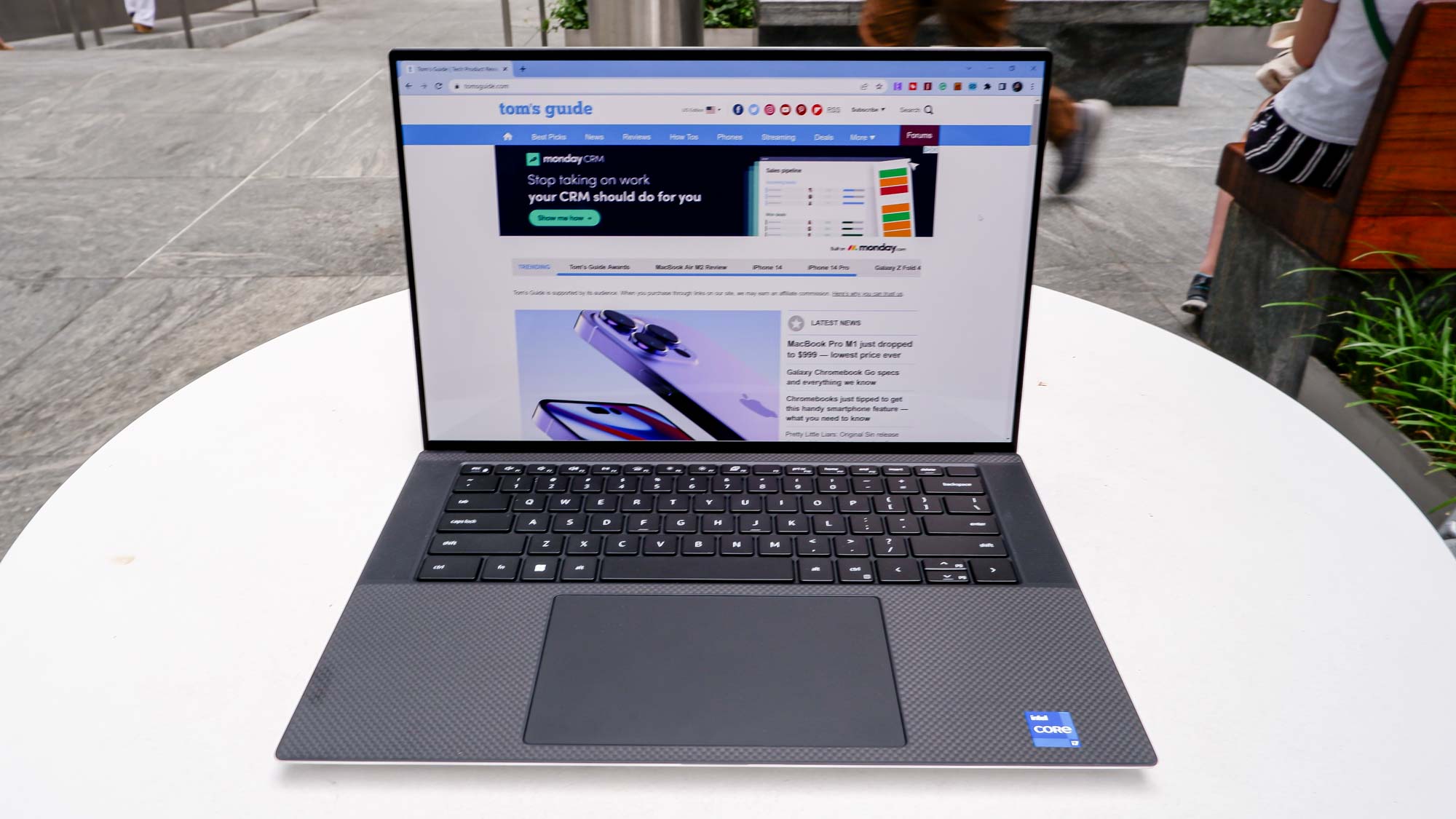
The new Dell XPS 15 features the familiar design language the XPS line is known for. These are some of the most elegant-looking Windows laptops, so it’s hard to complain about the unchanged design.
At 13.6 x 9.1 x 0.73 inches, the Dell XPS 15 is the definition of an ultraportable. Its machined aluminum chassis feels smooth and sturdy. It looks great at home, at a cafe or at the office. Save for the iconic Dell logo on its silver lid, the laptop is free of adornments. It’s somewhat heavy at 4.2 pounds but it’s still light enough to comfortably carry around. But overall, the Dell XPS 15 OLED is a sexy machine.
The 16-inch MacBook Pro 2021 has been redesigned in subtle but significant ways. It measures 14.01 x 9.77 x 0.66 inches and weighs 4.7 pounds. The 100% recycled aluminum chassis has a flatter lid than its predecessor, with vents carved out of either side in service of an improved cooling solution and a redesigned 6-speaker sound system inside.
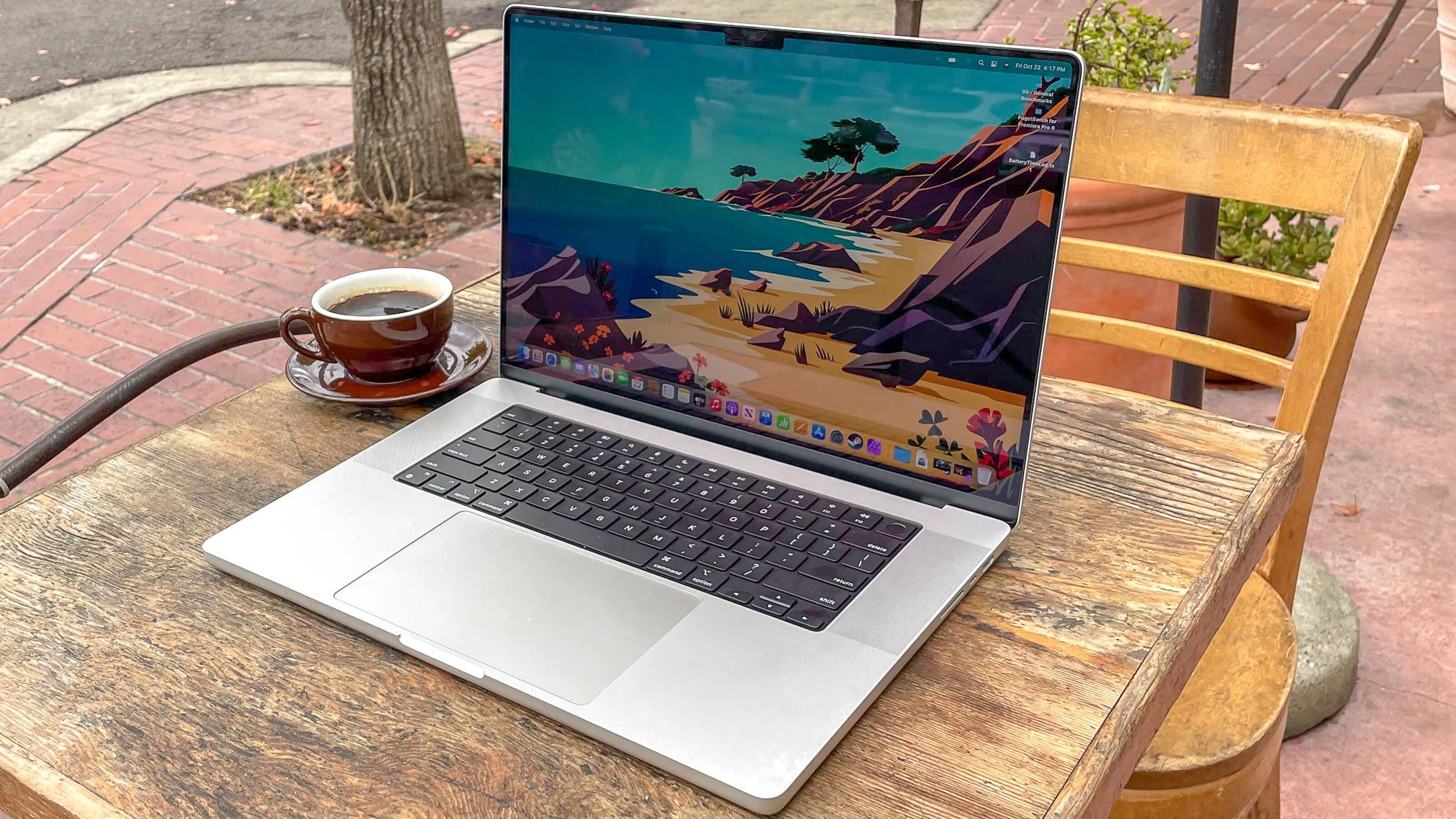
The notch is one of the most controversial design decisions Apple made with this laptop and the MacBook Pro 14-inch. Generally, macOS does a pretty smart job of tucking the Menu Bar into the thin ribbon of extra screen space on either side of the notch. But we found that you stop noticing the notch after a while, especially after staring at the gorgeous Liquid Retina XDR display.
The Dell laptop is thinner and lighter than the MacBook Pro. If portability is important to you, the XPS 15 OLED might be the more attractive option. But if you prefer a stockier machine that looks somewhat old-school, you may prefer the MacBook Pro 16-inch.
Dell XPS 15 OLED (2022) vs MacBook Pro 16-inch: Display
Streamed content and video games alike look fantastic on the 15.6-inch 3.5K OLED 60Hz InfinityEdge display. Equally, the large and vibrant 16:10 screen is ideal for work and scrolling through websites.
The XPS 15 registered an average brightness of 382 nits on our light meter, which is decent but not outstanding. In terms of color reproduction and accuracy, the XPS 15’s display registered 122% of the sRGB color gamut and 86.9% of the more demanding DCI-P3 color space (100% is most accurate).
The 16.2-inch Liquid Retina XDR display of the 16-inch MacBook Pro is one of the most beautiful screens we’ve ever seen on a laptop. It’s a bright, vibrant mini-LED (3,456 x 2,234) display with Apple's ProMotion adaptive refresh rate of up to 120 Hz.
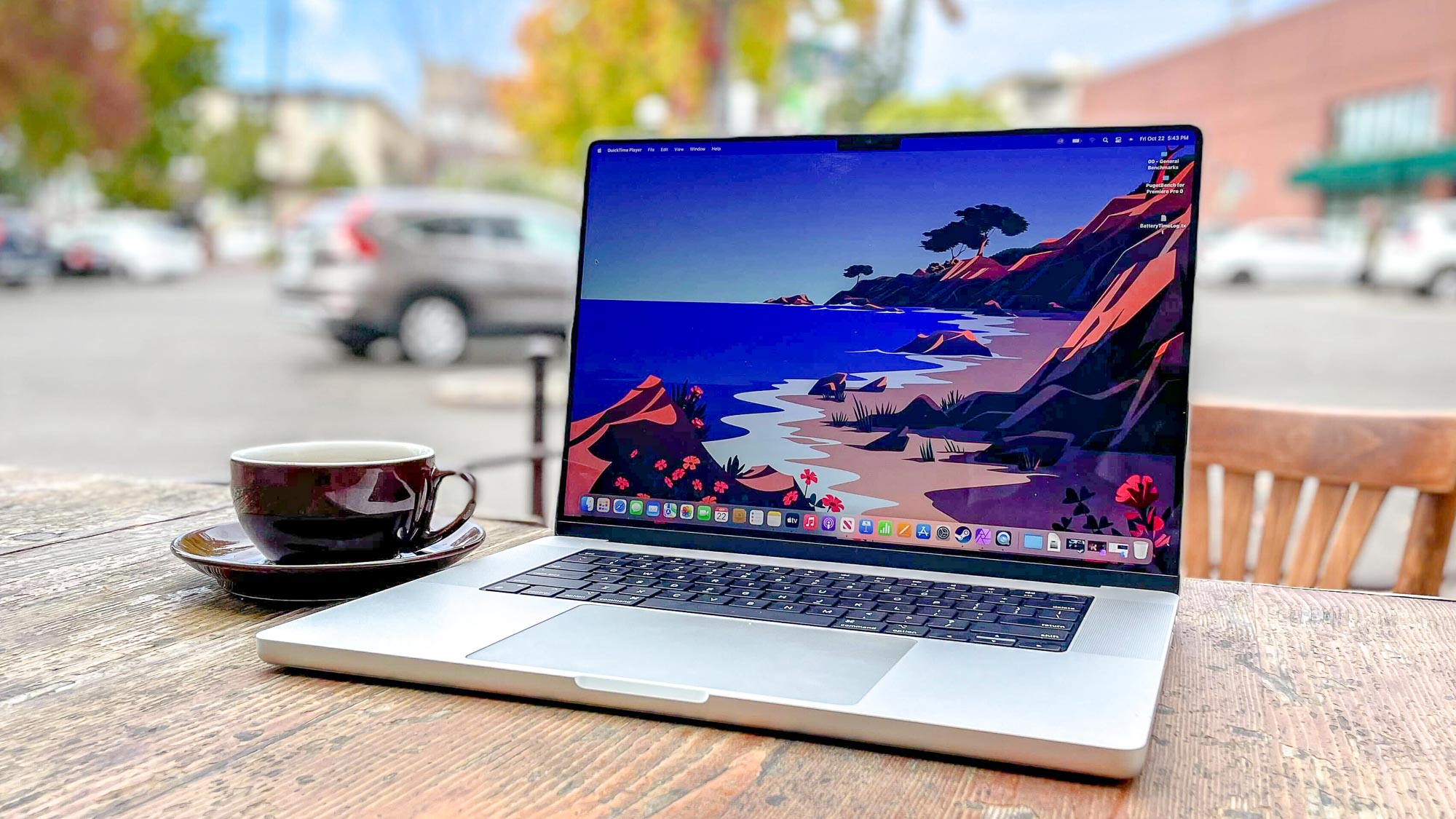
In our laboratory testing, we couldn’t get it any brighter than 520 nits, even while displaying HDR content with the screen cranked up to max brightness. When we pointed a colorimeter at the screen, we found it displays 109.3% of the sRGB color spectrum and 77.4% of the DCI-P3 color gamut.
The MacBook Pro 16-inch has a brighter display than the XPS 15 OLED and it’s capable of displaying at 120Hz. But despite topping out at 60Hz, Dell’s laptop has more accurate color representation and includes touch functionality. It’s hard to determine a clear winner in this category since each display has distinctive strengths and weaknesses.
Dell XPS 15 OLED (2022) vs MacBook Pro 16-inch: Ports
The Dell XPS 15 has three USB-C ports, a full-sized SD card slot, a headphone jack and a security slot for a Kensington lock. That’s not a lot of ports, but thankfully, Dell packs a USB-A and Ethernet adapter with the XPS 15. Though this still may not be enough ports for some people, it should be enough for everyday usage.
The MacBook Pro 16-inch has three USB-C ports, an SD memory card slot, an HDMI port, a headphone jack and a MagSafe port. We would’ve appreciated a USB-A port for legacy accessories, but you'll have to rely on dongles instead.
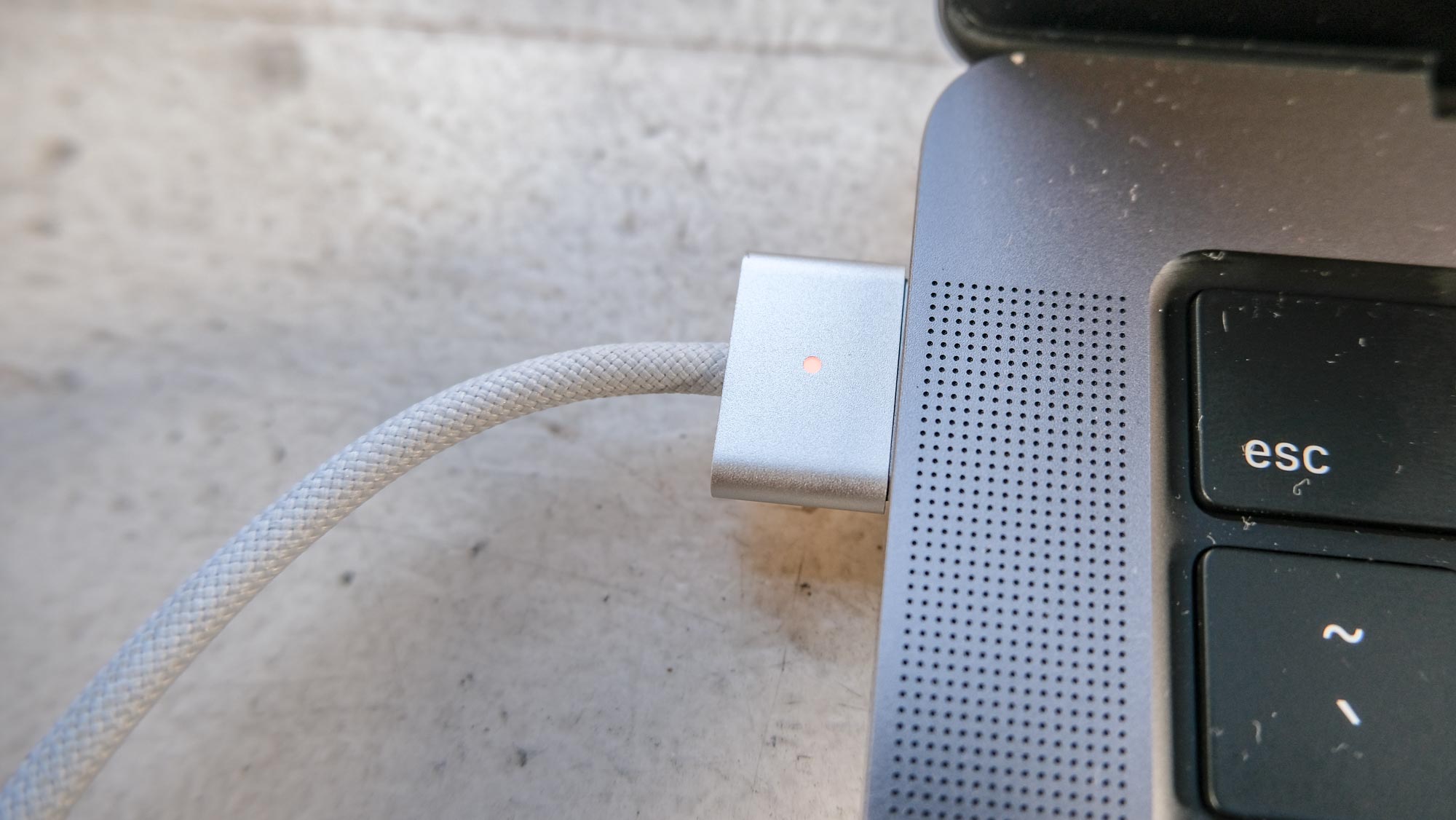
If you factor in the XPS 15 OLED’s included USB-A and Ethernet adapter, both laptops have a comparable amount of ports. You’ll need to occupy one USB-C port to use the XPS 15’s adapter, but this gives it a USB-A port – which is something the MacBook Pro 16-inch lacks entirely.
But Apple’s machine has MagSafe charging, which leaves all three of its USB-C ports free. The MacBook Pro also has a built-in HDMI port, whereas you need an adapter for that function on the Dell laptop.
Dell XPS 15 OLED (2022) vs MacBook Pro 16-inch: Performance
On Geekbench 5.4, which measures overall performance, the XPS 15 scored 11,258 on the multicore portion. On our Handbrake video editing test, which involves transcoding a 4K video clip to 1080p, the Dell XPS 15 took 5 minutes and 42 seconds to complete the task.
When benchmarking Sid Meier's Civilization VI on the laptop, the game reached 40 frames per second at 3.5K resolution. The game ran at 60fps at 1080p resolution. While this particular title isn’t technically demanding, those are still solid frame rates that most non-gaming laptops can't match.
Our 16-inch MacBook Pro came with the M1 Max chip. However, since the entry-level laptop packs an M1 Pro chip with 10 CPU and 16 GPU cores, we’ll use the results obtained from testing the Macbook Pro 14-inch, which had the same M1 Pro chip.
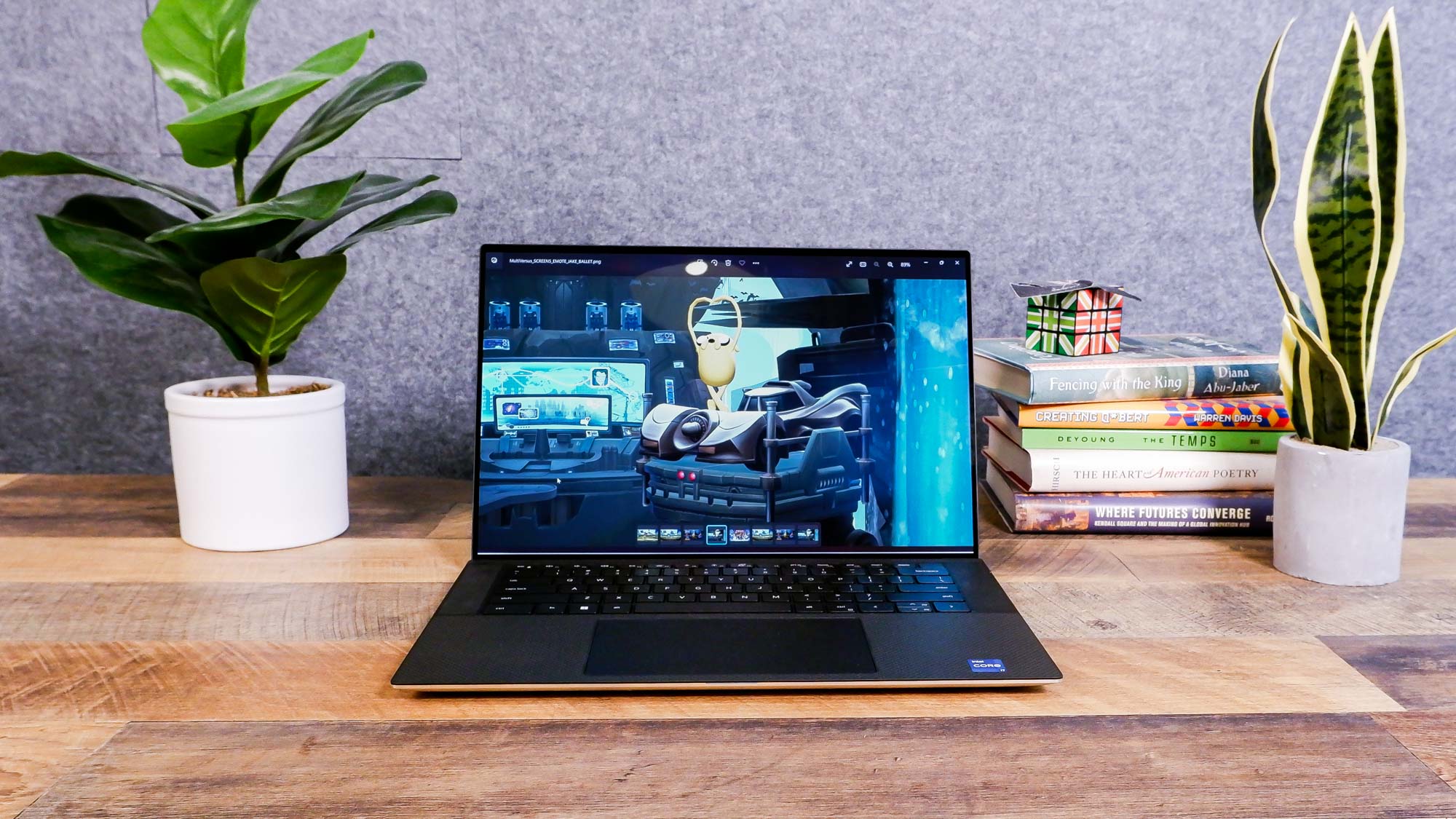
On the older Geekbench 5 general performance benchmark's multi-core test, the 14-inch MacBook Pro earned a whopping 12,477. On our Handbrake video encoding test, the M1 Pro-powered laptop took 4 minutes and 51 seconds to transcode a 4K video to 1080p.
The 14-inch MacBook Pro with an M1 Pro chip hit 39fps on Rise of the Tomb Raider (at 1920 x 1200). When we increased the resolution to 3024 x 1964, the laptop hit a choppy 17 fps. Civilization VI reached 45 fps at 1512 x 982 resolution.
Concerning overall performance, the MacBook Pro 16-inch with an M1 Pro chip is the clear winner. If you’re a professional video or audio editor, this machine should be on your radar.
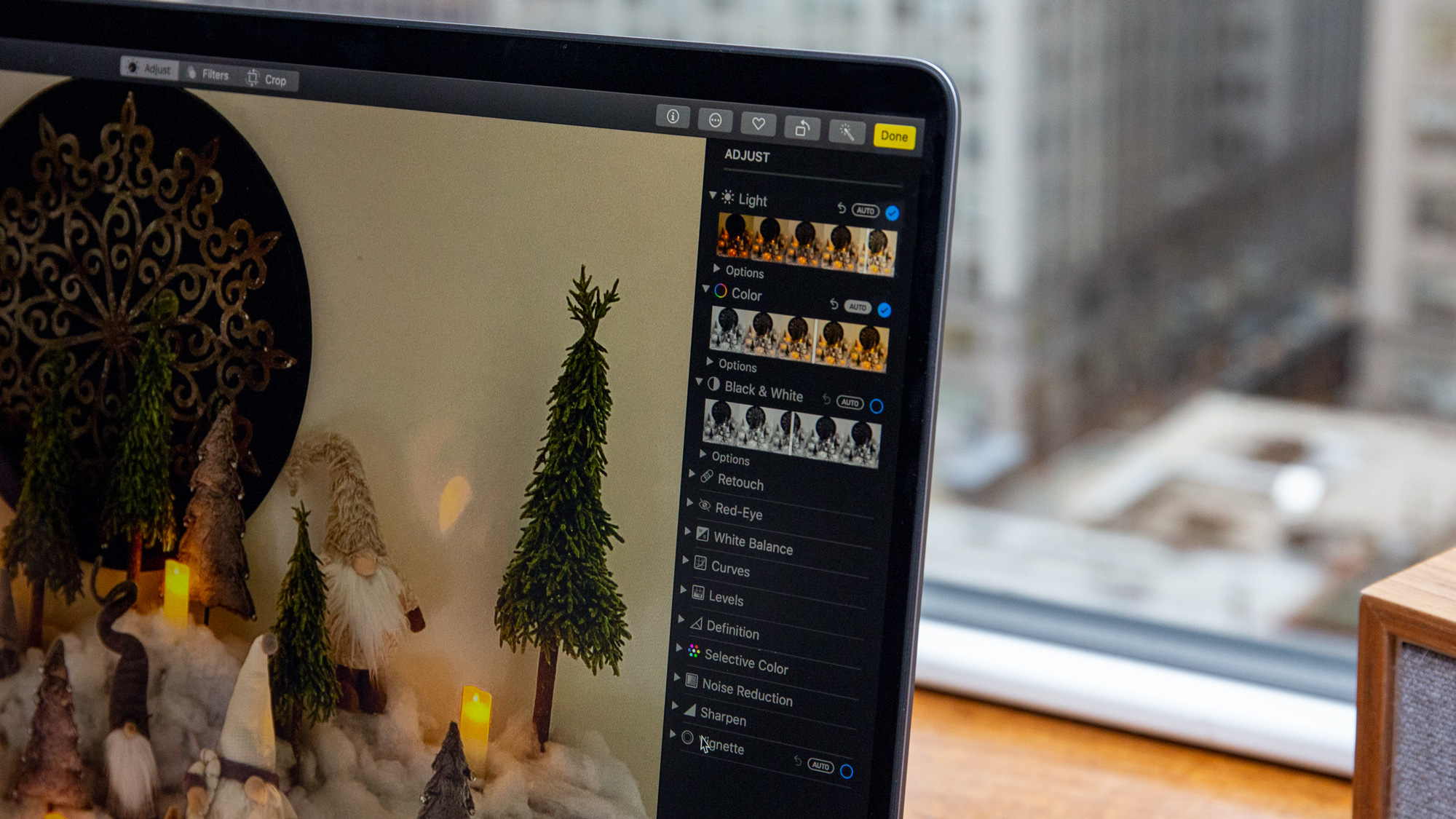
But while the XPS 15 OLED may not be as powerful overall, it’s capable of playing graphically-intensive games as good or better than some of the best gaming laptops. If you want to play games at 30 fps and above, the Dell laptop is a no-brainer.
Dell XPS 15 OLED (2022) vs MacBook Pro 16-inch: Speakers
The XPS 15 OLED has some of the best laptop speakers we’ve heard. The punchy speakers are loud enough to fill an entire room while remaining crystal clear even at high volumes. Bass isn't always great on laptops but the XPS 15 didn’t disappoint in that area. The included EQ program lets you fine-tune music, movies and games to your liking.
We found the MacBook Pro 16-inch’s speakers delivered great sound. Treble, vocals and bass all come through sharply and clearly. Movies like Dune sound appropriately cinematic thanks to Dolby Atmos support.
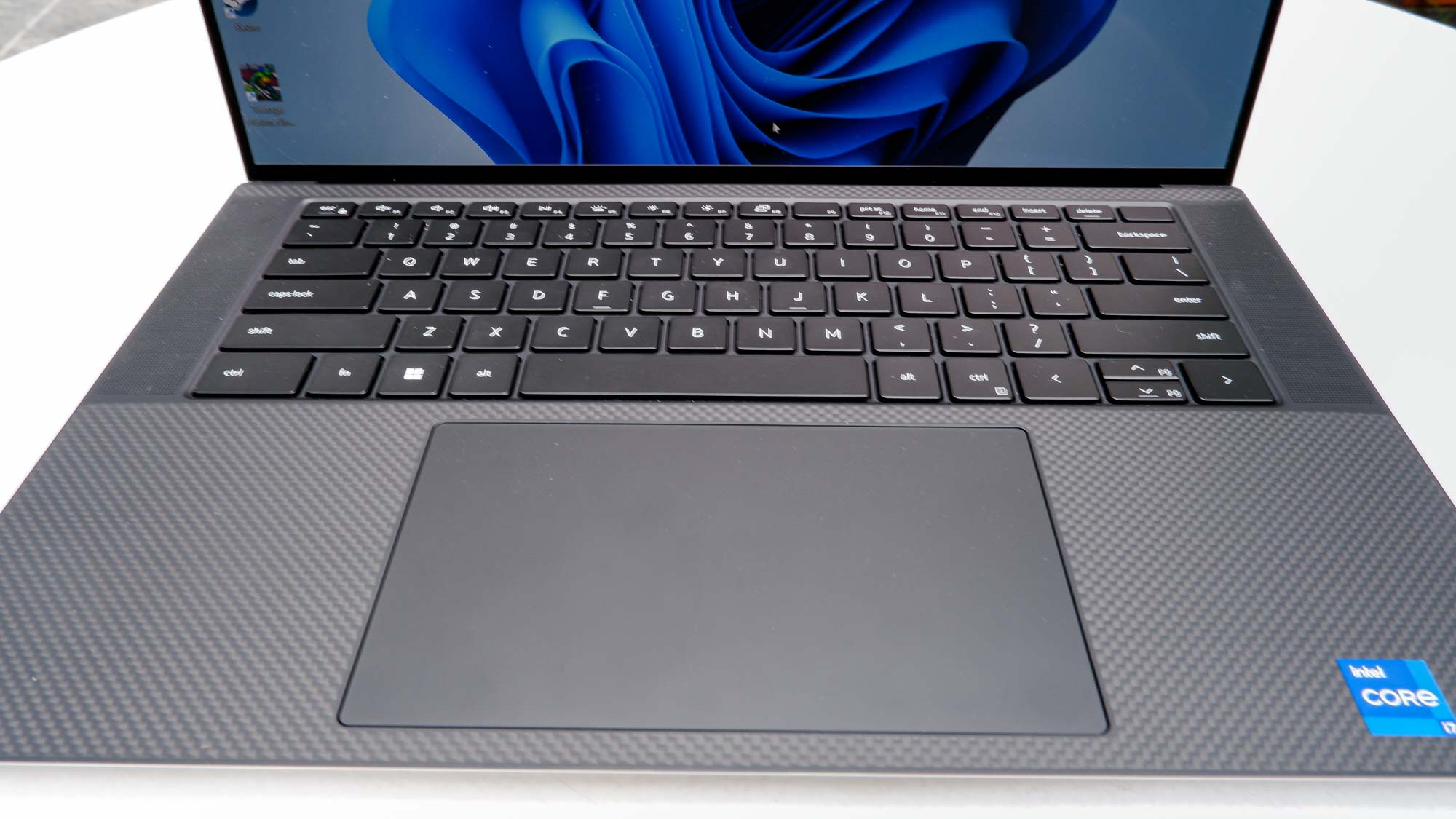
It’s hard choosing a winner here since both laptops deliver stunning sound. Anecdotally, I think the MacBook Pro 16-inch has slightly better sound since it has punchier bass than the XPS 15 OLED. But in the grand scheme of things, neither machine has poor audio quality.
Dell XPS 15 OLED (2022) vs MacBook Pro 16-inch: Webcam
The XPS 15 OLED’s 720p webcam is arguably its weakest feature. Even in good lighting, the picture quality looks grainy and washed out. This is an unacceptable webcam in an age where video conferencing has become so important.
The MacBook Pro 16-inch ships with a 1080p FaceTime HD webcam that does a great job of capturing detail in both photos and video. While the camera is a welcome step up from the grainy 720p webcams in most laptops, it doesn’t support Face ID, which means you can’t log in with your face the way you can on modern iPhones and iPads.
This one is no contest. The MacBook Pro 16-inch has a better webcam.
Dell XPS 15 OLED (2022) vs MacBook Pro 16-inch: Battery life
On the Tom’s Guide battery test, which involves continuous web surfing at 150 nits of screen brightness, the XPS 15 lasted for 10 hours and 5 minutes. In the same battery test, the 16-inch MacBook Pro 2021 delivered an outstanding 15 hours and 31 minutes of battery life on a single charge.
This is another category where the MacBook Pro 16-inch lands a decisive victory. Though it doesn’t have the epic battery life of the MacBook Pro M2, it will last for well over a day.
Dell XPS 15 OLED (2022) vs MacBook Pro 16-inch: Verdict
The Dell XPS 15 OLED (2022) is arguably the finest Windows laptop currently available. It has a fetching, modern design that’s simultaneously understated and attractive. And its virtues aren’t skin-deep, as it’s also a performant device that’s equally great for work and play. These aspects have made the Dell XPS one of the best in the industry and the XPS 15 OLED continues that legacy of excellence.
With that said, the MacBook Pro 16-inch is a monster that’s difficult to slay. Though it doesn’t excel at gaming, its power is ideal for professional video and audio editors. And like the XPS 15 OLED, the MacBook Pro 16-inch is more than capable of handling the computing needs of everyday users. All of that is wrapped in an elegant laptop that looks great anywhere.
This is one of the toughest matches to determine. Ultimately, it comes down to what you need and want. If you prefer the Windows platform and love playing high-end video games, then you should choose the Dell XPS 15 OLED (2022). Conversely, if you’re a professional editor who needs to tear through demanding workloads or if you’re already entrenched in the Apple ecosystem, you’re better off getting the MacBook Pro 16-inch.
Sign up to get the BEST of Tom's Guide direct to your inbox.
Get instant access to breaking news, the hottest reviews, great deals and helpful tips.

Tony is a computing writer at Tom’s Guide covering laptops, tablets, Windows, and iOS. During his off-hours, Tony enjoys reading comic books, playing video games, reading speculative fiction novels, and spending too much time on X/Twitter. His non-nerdy pursuits involve attending Hard Rock/Heavy Metal concerts and going to NYC bars with friends and colleagues. His work has appeared in publications such as Laptop Mag, PC Mag, and various independent gaming sites.
-
TCPHOENIX There is a mistake in this, the MacBook pro does not use Nvidia cards it swapped. Very important difference between the two.Reply -
rpuls Hi. sorry for that salty comment, but seriously. I spend 1 second glancing this article at found tons of super obvious errors. And to be frank it gets to me when I see a big media corp release an article that that leaves me thinking, that no one even cared to spend 1 minute proof reading it. You can't justify showing ads if your content is completely wrong and end up misleading people. Please get your game together.Reply
I'm not gonna point out the other errors that I spotted, as I hope that will mean that you are gonna proof read the entire article.
Again, sorry for the salty comment... But seriously, there's enough garbage information on the internet already, it's huge problem because people don't care to check sources or be critical these days, they just read something and then they go around and talk about it like it's for sure validated and credible information. Journalist have a huge responsibility that I don't see much commitment in - it's all about clicks and ad revenue. Please be the good example -
ibm650 Nothing is mentioned on the difficulty of moving data from Macs to PC, Apple intentionally does this.Reply -
MisterMark First, a question. How many people do you know that casually flip between the Apple ecosystem, software included, and the Windows world, merely because one was declared better/faster in a review? Next to no one, right? Reviews that do this serve no useful purpose. Most people have forgotten about MS's blue screen debacle and Apple's snarkiness about it long ago, if they even know about at it all.Reply
In the future please review Apple computers for the Apple audience and likewise for computers running Windows. Total newbies, which are next to nonexistent, will have to decide for themselves which platforms is best for them and deal with the many considerations involved.
Do better.
Regarding the blue screen comment, it was incomplete, and I should not have gone there in the first place.
